
Ducati unveiled some technical details of the “V21L” prototype, the MotoE first electrical motorcycle project from the Bologna-based manufacturer.
The prototype is illustrated in a video by the team that has overseen its creation and is following its development.
“V21L” in Borgo Panigale identifies Ducati’s first electric motorcycle, a prototype that starting from 2023 will compete in the FIM MotoE World Cup, of which the Bologna-based motorcycle manufacturer will be a partner as sole supplier with 18 bikes on the track during each race weekend.
Claudio Domenicali, Ducati CEO:
A few weeks ago I had the extraordinary opportunity to ride the Ducati MotoE on the track and I immediately realized that I was living in a historic moment. The world is going through a complex period and environmental sustainability is an element that all individuals and all companies must consider a priority if we want to preserve the delicate balance of the planet. As Ducati, we have grasped this need and we went in search of a challenge that would allow us to contribute to the common goal of reducing CO₂ emissions and at the same time to keep faith with our DNA linked to racing. We agreed with determination to develop the most performing electric racing bike that current technology makes possible and to use this project as a laboratory in which to build our future. The result we have achieved is surprising. As soon as I sat on the bike I realized the quality of the work done by the team and when I returned to the garage I felt a deep sense of pride for what we were once again able to achieve.
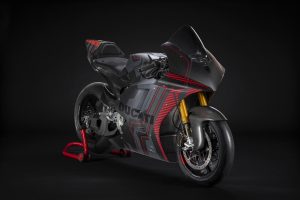 To produce the MotoE prototype, the Bologna-based motorcycle manufacturer put together a team that unites Ducati and Ducati Corse designers, creating a truly extraordinary mix of skills. The creation of the bike followed the procedure that is usually adopted for production bikes, triggering a close collaboration between the members of the team that led to new ways of thinking and designing, encouraged by such a technologically challenging project.
To produce the MotoE prototype, the Bologna-based motorcycle manufacturer put together a team that unites Ducati and Ducati Corse designers, creating a truly extraordinary mix of skills. The creation of the bike followed the procedure that is usually adopted for production bikes, triggering a close collaboration between the members of the team that led to new ways of thinking and designing, encouraged by such a technologically challenging project.
Ducati R&D took care of all the Project Management activities, together with the design and simulations on the electric powertrain, while the design of the MotoE was taken care by the Centro Stile Ducati which also created the livery of the bike. Ducati Corse, on the other hand, worked on the electronic parts design, on the software controls and strategies, on the simulations of the dynamics and aerodynamics of the motorcycle and finally on the bike assembly, testing and data acquisition processes.
The result to date is already satisfactory: the Ducati MotoE has a total weight of 225 kg (12 kg less than the minimum requirements imposed by Dorna and FIM for a bike capable of completing the race distance) and can count on maximum power and torque figures of 110 kW (150 hp) and 140 Nm respectively, which allowed it to reach a speed of 275 km/h on a circuit like Mugello (Italy).
The mix of expertise, passion and work of the Ducati MotoE team has led to the birth of an electric motorcycle with unique technical solutions. Starting with the battery pack, the most binding and characterizing element in terms of masses and dimensions, which on the Ducati MotoE is characterized by a shape specifically designed to follow the natural course of the middle area of the bike. The battery pack weighs 110 kg and offers a capacity of 18 kWh with a 20-kW charging socket integrated into the tail. Inside there are 1,152 cylindrical cells of the “21700” type.
The inverter, with a low weight of 5 kg, is a unit derived from a high-performance model used in motor racing for electric vehicles, while the motor (21 kg weight and a maximum rotation speed of 18,000 rpm) was developed by a partner following the technical specifications provided by Ducati. The entire system is based on a voltage of 800V (with a fully charged battery pack) to maximize the output of the electric powertrain and, as a consequence, performance and range.
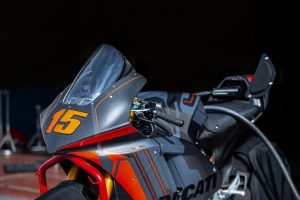 One of the most advanced technical solutions tested on the Ducati MotoE concerns the cooling system. The prototype components are in fact cooled by a particularly sophisticated and efficient liquid system with a double circuit designed to meet the different thermal needs of the battery pack and the motor/inverter unit . This guarantees extreme regularity of temperatures with important benefits in terms of consistency of performance but also in charging times. In fact, it is not necessary to wait for the battery pack to cool to start the process: the Ducati MotoE can be charged as soon as it enters the garage, and it takes about 45 minutes to recharge it up to 80% of its range.
One of the most advanced technical solutions tested on the Ducati MotoE concerns the cooling system. The prototype components are in fact cooled by a particularly sophisticated and efficient liquid system with a double circuit designed to meet the different thermal needs of the battery pack and the motor/inverter unit . This guarantees extreme regularity of temperatures with important benefits in terms of consistency of performance but also in charging times. In fact, it is not necessary to wait for the battery pack to cool to start the process: the Ducati MotoE can be charged as soon as it enters the garage, and it takes about 45 minutes to recharge it up to 80% of its range.
The carbon fibre case of the battery pack also acts as a stressed part of the chassis, like what happens for the Ducati Panigale V4 engine, with an aluminium monocoque Front Frame for the front area weighing 3.7 kg. The rear is composed of an aluminium swingarm weighing 4.8 kg with a geometry like that of the Ducati Desmosedici racing in MotoGP. The rear subframe, which integrates the tail and the rider seat, is made of carbon fibre.
The suspension area features an Öhlins NPX 25/30 pressurized fork with 43 mm diameter upside-down tubes at the front, derived from the Superleggera V4, while an Öhlins TTX36 shock absorber is present at the rear and is fully adjustable. The steering damper is an adjustable Öhlins unit.
The braking system is supplied by Brembo and is sized for the specific requirements of the Ducati MotoE. At the front it is composed of a double steel disc with a diameter of 338.5 mm of increased thickness, which has fins on the internal diameter with the aim of increasing the thermal exchange surface area and improve disc cooling in conditions of extreme use on the track. Two GP4RR M4 32/36 calipers with a PR19/18 radial master cylinder operate on this double disc. At the rear, the P34 caliper acts on a single disc unit 220 mm in diameter and 5 mm thick with a PS13 master cylinder. Teams can also choose to equip their bikes with an optional rear brake control positioned on the left handlebar, which the rider can use as an alternative to the pedal one.
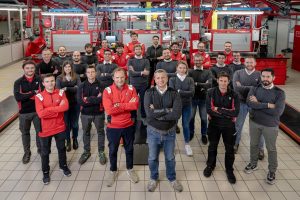 The development process of the Ducati MotoE also involved the Ducati Corse test team led by Marco Palmerini, who worked on the track applying the same methodologies used in MotoGP, thanks also to the support of the riders Michele Pirro, Alex De Angelis and Chaz Davies. Through the work on the electronics, the aim was to obtain a throttle response like that of an endothermic unit and a response from the electronic controls (such as Ducati Traction Control, Ducati Slide Control, Ducati Wheelie Control and throttle/engine brake maps) indistinguishable from that of the racing bikes that Ducati riders are used to.
The development process of the Ducati MotoE also involved the Ducati Corse test team led by Marco Palmerini, who worked on the track applying the same methodologies used in MotoGP, thanks also to the support of the riders Michele Pirro, Alex De Angelis and Chaz Davies. Through the work on the electronics, the aim was to obtain a throttle response like that of an endothermic unit and a response from the electronic controls (such as Ducati Traction Control, Ducati Slide Control, Ducati Wheelie Control and throttle/engine brake maps) indistinguishable from that of the racing bikes that Ducati riders are used to.
The possibility of applying the development and test method already used in MotoGP, with a precise sequence of tests to be carried out on the various components to maximize the performance of each day on the track, was achieved also thanks to the efficiency of the cooling system, which has reduced charging times to a minimum, thus allowing for a truly significant continuity of use for an electric motorcycle. The development work involved a specific learning and training course for all the personnel involved, exploiting the knowledge shared within the Volkswagen Group, to ensure the total safety of the rider and technicians.
The fact that Ducati belongs to the Volkswagen Group, which has made electric mobility an essential element of its “New Auto” 2030 strategy, represents the best prerequisite for an extraordinary exchange of expertise in the field of electric powertrains. Ducati is in close contact with the Group’s centres of expertise and with the Centre of Excellence (CoE) at Salzgitter in Germany, but also with other brands of the Group such as Porsche and Lamborghini.
The work plan of the Ducati MotoE project has already reached an advanced stage of development and is proceeding at a rapid pace towards 2023, the year in which Ducati will take on the role of sole supplier of the FIM MotoE World Cup with 18 electric motorcycles on the track every weekend. The next objective for the Bologna-based manufacturer is to take advantage of participation in the most important racing competition in the world for electric motorcycles to experiment with innovative technologies, train new skills and study how to create, as soon as the technology will allow, a Ducati electric vehicle that is sporty, light, exciting and able to satisfy all enthusiasts.
Source: Ducati










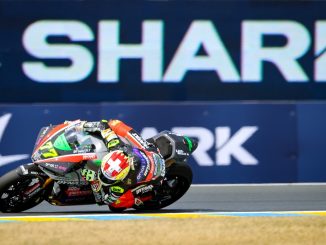

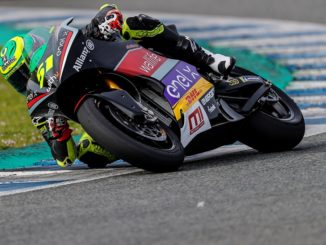
Be the first to comment